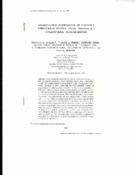Mostrar el registro sencillo del ítem
Aggregation Pheromone of Coconut Rhinoceros Beetle, Oryctes rhinoceros (L.) (Coleoptera: Scarabaeidae)
| dc.creator | Hallett, Rebecca H. | |
| dc.creator | Pérez Sánchez, Alice Lorena | |
| dc.creator | Gries, Gerhard | |
| dc.creator | Gries, Regine | |
| dc.creator | Pierce Jr., Harold D. | |
| dc.creator | Yue, Junming | |
| dc.creator | Oehlschlager, Allan Cameron | |
| dc.creator | González, Lilliana M. | |
| dc.creator | Borden, John H. | |
| dc.date.accessioned | 2016-06-23T21:44:53Z | |
| dc.date.available | 2016-06-23T21:44:53Z | |
| dc.date.issued | 1995-10 | |
| dc.identifier.citation | http://link.springer.com/article/10.1007%2FBF02035152 | |
| dc.identifier.issn | 1573-1561 | |
| dc.identifier.uri | https://hdl.handle.net/10669/28124 | |
| dc.description.abstract | Male coconut rhinoceros beetles,Oryctes rhinoceros (L.), produce three sex-specific compounds, ethyl 4-methyloctanoate, ethyl 4-methylheptanoate, and 4-methyloctanoic acid, the first of which is an aggregation pheromone. Synthesis of these compounds involving conjugate addition of organocuprates to ethyl acrylate is reported. In field trapping experiments, (4S)-ethyl 4-methyloctanoate and the racemic mixture were equally attractive and 10 times more effective in attracting beetles than ethyl chrysanthemumate, a previously recommended attractant. Ethyl 4-methylheptanoate was as attractive as ethyl chrysanthemumate and more attractive than 4-methyloctanoic acid, but further studies are required before it can be classed as an aggregation pheromone. Compared to ethyl 4-methyloctanoate alone, combinations of the three male-produced compounds did not increase attraction, whereas addition of freshly rotting oil palm fruit bunches to pheromone-baited traps significantly enhanced attraction. With increasing dose, captures of O. rhinoceros increased, but doses of 6, 9, and 18 mg/day were competitive with 30 mg/day lures. Newly designed vane traps were more effective in capturing beetles than were barrier or pitfall traps. Results of this study indicate that there is potential for using ethyl 4-methyloctanoate in operational programs to control O. rhinoceros in oil palm plantations. | es_ES |
| dc.description.sponsorship | Chem Tica International | es_ES |
| dc.language.iso | en_US | es_ES |
| dc.relation.ispartofseries | Journal of Chemical Ecology;Volumen 21, número 10 | es_ES |
| dc.source | Journal of Chemical Ecology 21(10), Octubre 1995 | es_ES |
| dc.subject | Coleoptera | es_ES |
| dc.subject | Scarabaeidae | es_ES |
| dc.subject | Oryctes rhinoceros | es_ES |
| dc.subject | coconut rhinoceros beetle | es_ES |
| dc.subject | Aggregation pheromones | es_ES |
| dc.subject | Pheromone chirality | es_ES |
| dc.subject | ethyl 4-methyloctanoate | es_ES |
| dc.subject | ethyl 4-methylheptanoate | es_ES |
| dc.subject | 4-methyloctanoic acid | es_ES |
| dc.title | Aggregation Pheromone of Coconut Rhinoceros Beetle, Oryctes rhinoceros (L.) (Coleoptera: Scarabaeidae) | es_ES |
| dc.type | artículo original | |
| dc.description.procedence | UCR::Vicerrectoría de Investigación::Unidades de Investigación::Ciencias Básicas::Centro de Investigaciones en Productos Naturales (CIPRONA) | es_ES |
Ficheros en el ítem
Este ítem aparece en la(s) siguiente(s) colección(ones)
-
Química [360]


